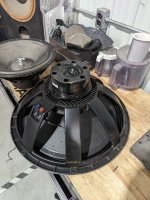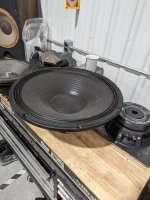Hey guys
Years ago when I was really into home theater I bought this RCF 21" woofer and had it in a massive ported box under a workbench in my parents basement. I moved into an apartment about 5 years ago and this driver has been sitting in storage in an ocean container behind my shop ever since.
I just bought a 2500 square foot house where I can now do whatever I want so it's time to bring all the old gear out of storage. I was planning to pair this in some way with my Martin Logan Aerius I speakers. I'm not moved in until December 17th so I don't have room dimensions and I'm not even sure where I'll be putting everything.
I was wondering if anyone could shed some light on how I could make the most of this driver? I would power it with Behringer EPX2800 and use my Dayton 4X8 DSP to set the crossovers. Or should I just scrap the idea entirely and go another route? I'm pretty open to any and all ideas.
Years ago when I was really into home theater I bought this RCF 21" woofer and had it in a massive ported box under a workbench in my parents basement. I moved into an apartment about 5 years ago and this driver has been sitting in storage in an ocean container behind my shop ever since.
I just bought a 2500 square foot house where I can now do whatever I want so it's time to bring all the old gear out of storage. I was planning to pair this in some way with my Martin Logan Aerius I speakers. I'm not moved in until December 17th so I don't have room dimensions and I'm not even sure where I'll be putting everything.
I was wondering if anyone could shed some light on how I could make the most of this driver? I would power it with Behringer EPX2800 and use my Dayton 4X8 DSP to set the crossovers. Or should I just scrap the idea entirely and go another route? I'm pretty open to any and all ideas.
Attachments
There's a good PA oriented design at https://forums.prosoundweb.com/index.php/topic,138662.0.html, not sure if it will suit you in terms of extension vs output, are you looking for mostly music reproduction or more cinema style VLF stuff?
Sorry I should have specified my application. This would just be used for music and maybe video games depending where my computer ends up.
I'll have a look at the link you posted.
I'll have a look at the link you posted.
(I don't belong to Facebook) - look for the High Order Quarterwave
Societies postings at Facebook - there may be something there to fit your needs / frequency extension. There used to be a link which accessed the many designs w/o going through Facebook but I cannot find it.
Societies postings at Facebook - there may be something there to fit your needs / frequency extension. There used to be a link which accessed the many designs w/o going through Facebook but I cannot find it.
The cabinet in the link has an Fb of 32 Hz, like any bass reflex, not much useful output below Fb. It's large elliptical profile port really does reduce port compression and noise, important to get the most out of such a large displacement driver.Sorry I should have specified my application. This would just be used for music and maybe video games depending where my computer ends up.
I'll have a look at the link you posted.
Very good design for size vs extension for PA use, but a larger cabinet tuned lower could get useful output down to 20Hz (or lower) at reduced level, still enough to shake the walls of your house and stomach.
I come from a PA background, but find extension below 30Hz worth the reduced output potential for a fair amount of the music I listen to. If your video games are like a lot of current movies, they may have response well below 20Hz.
Tapped Horn or High Order Quarterwave designs could get even more output down low, but have to be much larger to do so.
You have space and move into a new house.
If you do not mind you can do a fixed installation with a box out of stone.
You can use bricks for doing that.
I have access to marble which I can get ready made from the stonemason



8cm reflex Port for 8 inch driver will be added


If you do not mind you can do a fixed installation with a box out of stone.
You can use bricks for doing that.
I have access to marble which I can get ready made from the stonemason
8cm reflex Port for 8 inch driver will be added
Saw once a room installation for a legendary 80cm Polystyrol cone driver, forgot producers name:
1000 liter closed box made of bricks along the long side of the room. Hope my bad image is understandable.

1000 liter closed box made of bricks along the long side of the room. Hope my bad image is understandable.
@weltersys thanks for the info, that cabinet seems to have some decent plans to build from so that's nice. I have limited experience in modeling subwoofers in different enclosures, really just some basic sealed and ported boxes in WinISD I've built over the years (with mixed success). I have zero experience designing things outside of those basic enclosures.
I was originally planning on just throwing this in a sealed box and call it a day. But I figured I'd stop by this place and see what ideas everyone had. Do you have any recommendations on software to possibly model what you're talking about?
I was originally planning on just throwing this in a sealed box and call it a day. But I figured I'd stop by this place and see what ideas everyone had. Do you have any recommendations on software to possibly model what you're talking about?
You have space and move into a new house.
If you do not mind you can do a fixed installation with a box out of stone.
You can use bricks for doing that.
I have access to marble which I can get ready made from the stonemason
I've heard of people building enclosures out of cement but I've never seen marble before. I think I'm probably going to stick with birch ply for this though haha, I'm not ready for a stone subwoofer box.
I modelled your twenty-one inch driver for ya'...I got a 750 mm wall cube (325L) (very little clearance)...tuned to 39 hertz. Put some legs on it, propped up 100+ mm high, port firing downwards...getting ya' -3.09 Db at 36.12 hertz.
--------------------------------------------------------------------------------------------------------------------------------------------------------------------------Rick...
--------------------------------------------------------------------------------------------------------------------------------------------------------------------------Rick...
https://www.avsforum.com/forum/113-...mate-list-bass-movies-w-frequency-charts.htmlI come from a PA background, but find extension below 30Hz worth the reduced output potential for a fair amount of the music I listen to. If your video games are like a lot of current movies, they may have response well below 20Hz.
best movies for me aren't on that list - pre-code - classic horror - old sci-fi - -how low did the original "The Day The Earth Stood Still" and "Forbidden Planet" go ?
My two faves, especially 'FP' with sexy Anne Francis! 👍 😎 Speakers designed for 30-40 Hz, but according to the W.E. mono specs a 70 Hz HP filter was required, though Altec designed the speaker systems for a 70 - 80 Hz roll off, though with another type sound system it was set to ~35 Hz with neither listing SPLs in theaters except (-x dB) reference, so can only assume it was ~ the Atlanta Fox Theater's early '70s measured ~85 dB ~2/3 back of the seating area from screen and ~105 dB for folks in the 1st 1/3 where I like(d) to sit.
http://www.widescreenmuseum.com/widescreen/perspecta-altec.htm
http://www.widescreenmuseum.com/widescreen/perspecta-altec.htm
Hornresp is an excellent modeling tool designed by David McBean who also has a sticky thread in this subwoofer forum.@weltersys thanks for the info, that cabinet seems to have some decent plans to build from so that's nice. I have limited experience in modeling subwoofers in different enclosures, really just some basic sealed and ported boxes in WinISD I've built over the years (with mixed success). I have zero experience designing things outside of those basic enclosures.
I was originally planning on just throwing this in a sealed box and call it a day. But I figured I'd stop by this place and see what ideas everyone had. Do you have any recommendations on software to possibly model what you're talking about?
http://www.hornresp.net/
Takes a while to learn, but makes comparisons of virtually any type of design possible.
Here is what the output of the RCF LF21N451 in a large sealed cabinet compared to ported 20Hz Fb of the same gross volume looks like:
Using the 13mm Xmax (linear displacement) figure from RCF's spec sheet, the sealed cabinet (regardless of size) can only produce about 107dB SPL at 20 Hz in half space (2.0xPi), while the ported cabinet can do near 120 dB.
At 20Hz, around 5dB increase in SPL sounds twice as loud, the ported output would sound around four times louder than the sealed.
Here is a further look at the 20Hz Fb Hornresp simulation:
The port resonance peak/dip around 125Hz will probably not be as severe as the sim predicts, and as the port may be folded to fit in the cabinet, may be pushed further up out of the sub's pass-band. The rising response can easily be tamed with DSP, and may actually be less, as the voice coil Le of 3mH likely will higher at sub frequencies than the 1kHz specified in the TS parameters.
There is a Hornresp "large voice coil" (or something like that..) function that can be engaged to emulate the effect.
A BW24 HP a few Hz below Fb will keep excursion under control, though the driver's suspension won't allow near as much as predicted.
The large port has low particle velocity, so it won't "chuff" or compress at the voltage required to push the cone to Xmax above and below Fb:
Using an elliptical port profile would reduce port velocity further, you could probably get away with less port area, which would allow a shorter port length, pushing the port resonance higher.
Anyway, getting a lot of output down low is possible with a driver like you have- go for it!
Art
Last edited:
Hey GM, where did you get the 15mm xmax and 2K watts power handling?
https://www.parts-express.com/RCF-L...jpb8Lg3XOmo5mJe0ezNfswniM5v96t5RoC1-8QAvD_BwE
https://www.parts-express.com/RCF-L...jpb8Lg3XOmo5mJe0ezNfswniM5v96t5RoC1-8QAvD_BwE
Hey guys
Thanks to everyone for all the information, going to have to sit down and review all of this and get a better understanding of what I'm actually looking at. You guys have been very helpful. I'm also going to download Hornresp and have a look around.
from what I gather a decent size ported box tuned reasonably low is the way to go.
Thanks to everyone for all the information, going to have to sit down and review all of this and get a better understanding of what I'm actually looking at. You guys have been very helpful. I'm also going to download Hornresp and have a look around.
from what I gather a decent size ported box tuned reasonably low is the way to go.
I got it from someone else's Paraflex HR sim, though looking at RCF's specs it's 13 mmHey GM, where did you get the 15mm xmax and 2K watts power handling?
Attachments
- Home
- Loudspeakers
- Subwoofers
- RCF 21" woofer LF21N451


